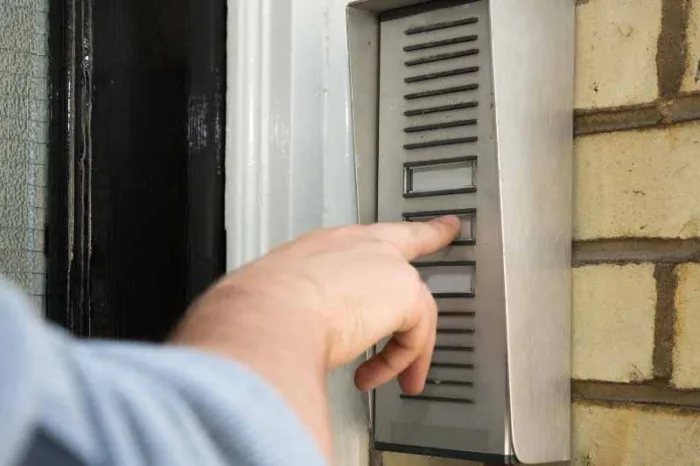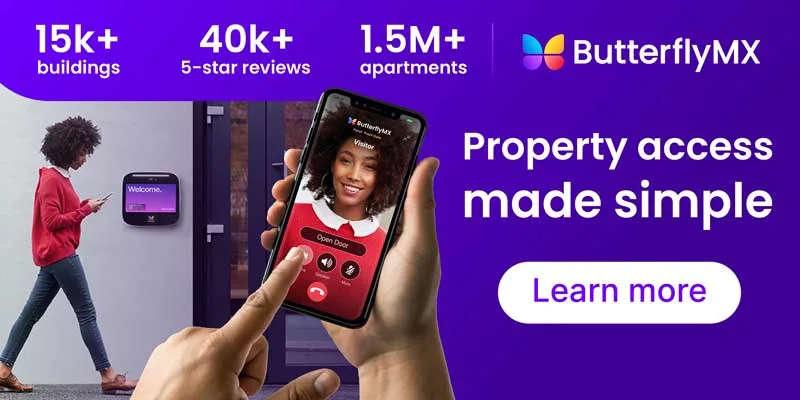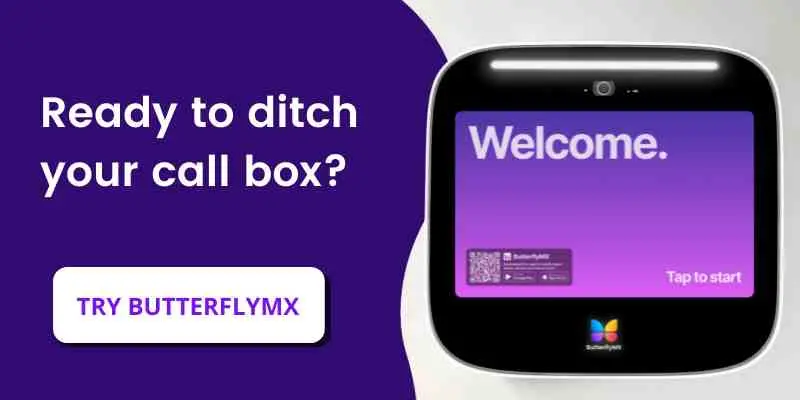Takeaways
- A wireless call box is a wireless system that allows visitors to call a resident in a building.
- The types of call boxes are two-way radio call boxes, cellular network call boxes, and WiFi call boxes.
- ButterflyMX’s video intercom has remote accessibility features, keyless entry, and face-to-face communication.
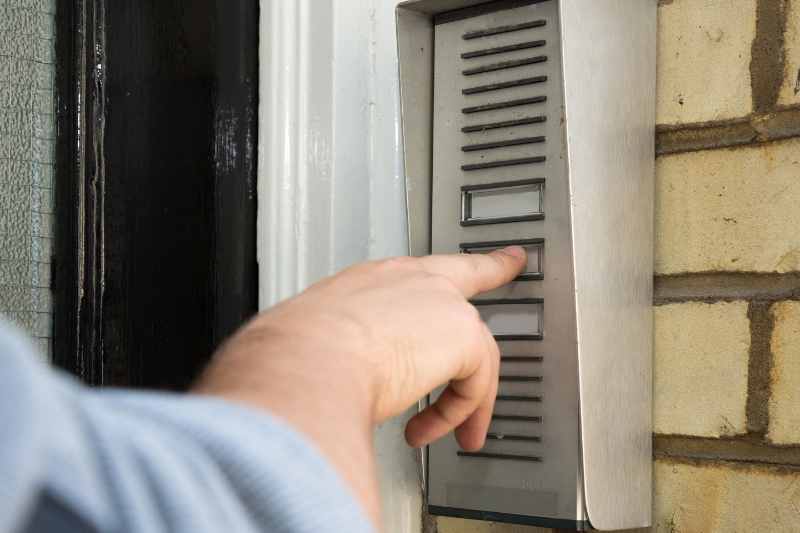
Whether you’re looking for an entry system for a building in development or retrofitting one into an existing property, you might be considering a wireless apartment call box. You already know that you need a way for visitors to contact tenants, and you want to reduce installation costs by choosing a wireless system. But is a traditional wireless call box the right system for your property?
In this post, we’ll review the best call boxes to buy. Next, we’ll go over how it works. Finally, we’ll cover the different types of call boxes and where they can be used.
This buyer’s guide covers:
- Best wireless call boxes to buy
- What is a wireless call box?
- What are the different types of wireless call boxes?
- Where to use wireless call boxes
Best wireless call boxes to buy
The best wireless call box to buy will depend on your unique property type. The number of daily users and the individual design of your entryway all play a factor in determining which device is best for you.
The best wireless call boxes for sale include:
1. ButterflyMX
Traditional call boxes remain an outdated property access solution, offering little in the way of convenience and security compared to more modern entry systems. With that said, the best wireless call box is the ButterflyMX video intercom.
ButterflyMX is a cloud-based access control company offering property-wide access solutions, from the front door or gate to garages, elevators, and amenity spaces. With more than 10,000 building installations across the United States, ButterflyMX is a leader in cloud-based door entry solutions.
Here are just a few reasons why you should choose ButterflyMX’s video intercom:
- Keyless entry. Instead of carrying around cumbersome keys, residents can let themselves into the building via their mobile devices.
- Remote access management. Residents can unlock doors and gates from anywhere by using their mobile devices. That means that they can let in their guests even when they’re not home.
- Increased security. Residents can see who they are speaking with before letting anyone into the building. Furthermore, a time-and-date-stamped recording of every entry event is stored in the cloud.
- Cloud-based software. Software updates are downloaded automatically, reducing the need for maintenance.
- IP65 rating. ButterflyMX products are resistant to adverse weather conditions.
- Easy installation. The ButterflyMX video intercom doesn’t require any complex wiring.
Watch how ButterflyMX works:
2. Ritron
The Ritron wireless 2-way, push-to-talk intercoms cost between $750 and $2,130. They run on 3D alkaline batteries that are good for around 5,000 transmissions. Their outside operating range extends for up to 1 mile. Their inside range covers about 150,000 square feet. As a result, these are likely good for large properties with a low volume of users.
3. Linear
The Linear wireless estate intercom includes a rechargeable battery and can make calls via a keypad. Two-way communication covers up to 500 feet, making them ideal for smaller properties. The interior intercom is mobile and can be placed anywhere within your property.
4. Ultracom2
The Ultracom2 wireless gate and door intercom is powered by 4C batteries. It features push-to-talk digital communication, voltage-free door lock and release, and a portable handset that will respond to the intercom. Multiple devices can be installed at different gates and controlled from the same handset across your property.
What is a wireless call box?
A wireless call box is a communication device that allows a visitor to call a tenant in a building or on a property. Most wireless call boxes also provide a way for tenants to grant property access to their visitors remotely.
Wireless door call boxes are a form of access control for buildings. They ensure that doors remain locked to prevent unauthorized people from entering while granting access to authorized tenants and visitors. You can also install a wireless gate call box at a gated property to control vehicle access.
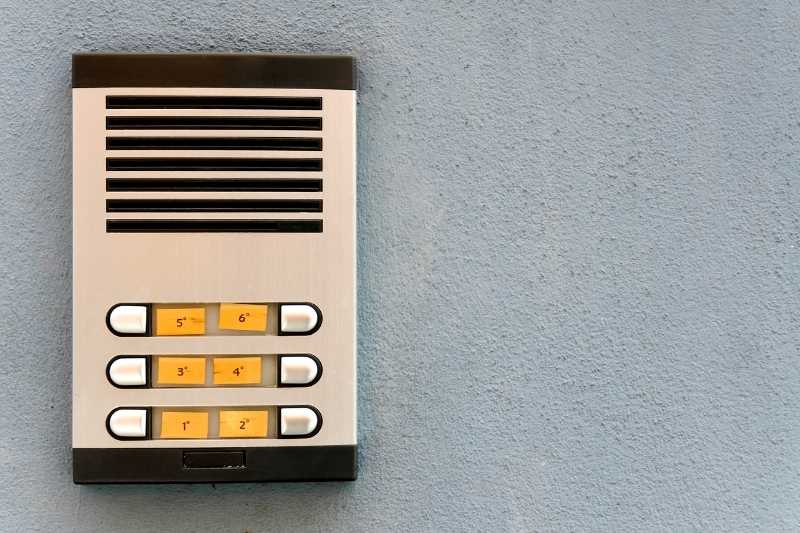
Wired vs. wireless call boxes
The difference between a wired and wireless call box is in how they transmit audio (and sometimes video) data between devices.
Wired call boxes require a wired connection between the hardware at the property’s entrance (the base station) and the hardware within the building (the substations). Similar to a telephone entry system, a wired call box transmits audio from one device to another via wiring. As a result, wired call boxes require additional wiring that is expensive to install and maintain.
In contrast, a wireless call box system transmits data wirelessly, generally over a cellular or WiFi connection. So, you don’t need to physically connect the system’s base station to each substation throughout your property. This eliminates the additional material and labor costs.
How much does a wireless call box cost?
Wireless call boxes typically cost between $1,000 and $3,000. This all depends on the type of system you purchase. This price does not include installation, maintenance, or ongoing fees.
What are the different types of wireless call boxes?
If you are considering a wireless call box for your property, you might be wondering what your options are.
There are three main types of wireless call boxes:
Two-way radio call box
Historically, the first wireless apartment call boxes were systems that enabled communication between people via two-way radio frequencies. Similar to walkie-talkies, these rudimentary push-to-talk devices allow two people — such as a visitor and a building tenant — to talk to each other by pressing a button.
When one person pushes the ‘talk’ button on a two-way radio call box, the system transfers their audio data to the other person’s device through radio waves. These devices can either be hand-held or wall-mounted. More advanced two-way radio call boxes can also be connected to a door release, which allows tenants to open the door or gate remotely.
Keep in mind: Some radio call box systems may require an FCC license to operate.
Cellular network call box
Considering the advancements in cellular technology, some wireless call boxes now operate over cellular networks. These types of call boxes — also called cellular telephone entry systems — can dial any landline or mobile phone.
Compared to radio call box systems, cellular call boxes offer a greater range since they aren’t limited by the distance the radio frequencies can travel. However, they can be pricey since they require you to pay for an additional cell service plan.
When cellular network call boxes are connected to an electronic or magnetic lock, they also enable tenants to open doors and gates with their cell phones.
WiFi call box
Instead of operating over a cellular network, WiFi call boxes place calls via WiFi. Some systems also allow for a wired Ethernet connection, which may be more stable.
As an internet-based entry system, a WiFi call box is generally the simplest to use and manage. Some systems even pair with a mobile app for smartphone-based access. However, WiFi call boxes require a strong and stable connection and are affected by internet outages.
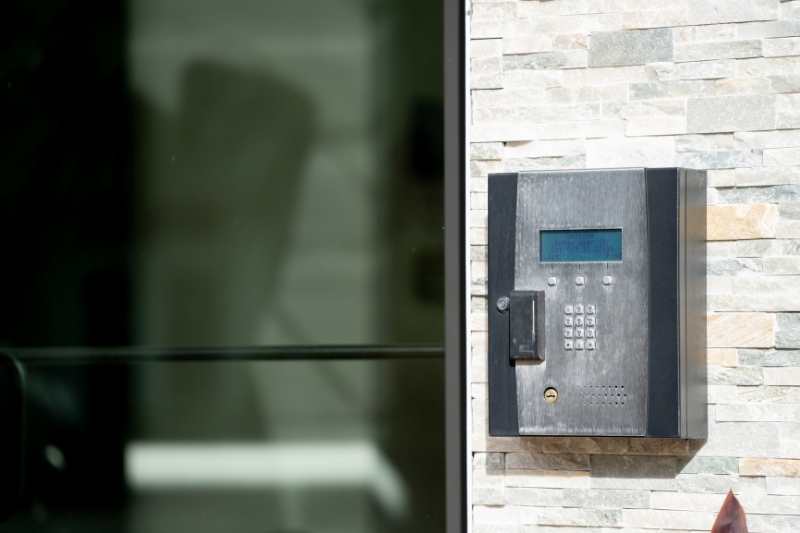
Where to use a wireless call box
You can install and use a wireless call box on any property that needs controlled access or a solution for people to easily communicate from a distance.
You’ll likely find wireless call boxes at:
Apartments
An apartment call box allows visitors to contact the building’s residents easily and enables residents to buzz them in remotely. Multifamily buildings benefit from having a call box because they ensure that residents never miss a visitor. Additionally, they prevent property staff from having to vet visitors and grant them access around the clock.
Wireless call boxes also reduce missed deliveries and package theft at apartments. With a call box at the property’s entrance, delivery carriers always have a way to alert residents they’ve arrived and request property access.
Apartment building owners and operators appreciate wireless call boxes because they’re easier and more affordable to install. Call boxes that operate over a cellular network or the internet are preferable, as they eliminate the need to install hardware in every apartment unit.
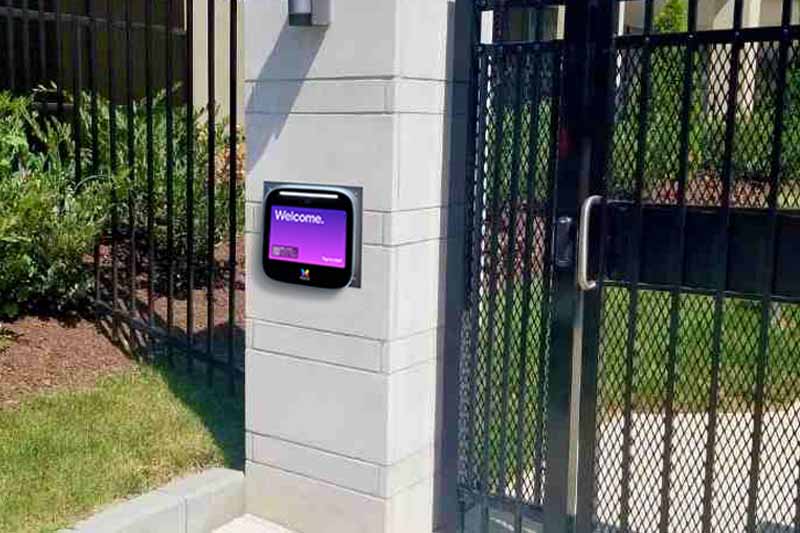
Commercial buildings and offices
Commercial buildings benefit from having a wireless call box to manage visitors and increase security. With a call box at the entrance to your commercial building, you can leave the doors locked to keep tenants safe while providing a reliable way for visitors to request access.
Wireless call boxes can be installed at entrances to offices and businesses with or without a front desk. If your building does have a front desk with staff to greet visitors, the call box can place calls directly to that staff member. Alternatively, you can program the system to allow visitors to call individual tenants.
Gated communities
A wireless call box is one common way to control access at gated communities. Gated properties benefit from a wireless gate call box because you don’t have to lay extensive wiring between the gated entrance and each unit or building on the property. Additionally, having an entry system allows tenants to open the gate for their guests remotely without having to physically go to the property entrance.
Every gated property — both multifamily and commercial — needs some sort of gate access control. Controlling access at gated entrances ensures property security and adds convenience for tenants, visitors, staff, and delivery carriers.
For best results, choose a gate intercom with a camera. That way, tenants can see who’s at the gate when talking to them, maximizing security. However, keep in mind that most camera-equipped call boxes only provide one-way video footage. This is because call box base stations rarely have a screen to display video. As a result, visitors can’t see residents when calling them, which isn’t an ideal experience.
Childcare facilities
Because of increased security across the country, many childcare facilities, such as daycares, require access control. A call box is one such option that won’t be disruptive to students and staff.
All guests can be verified for their identities to ensure that they have permission to enter the property. Parents can use the device to verify their identity and pick up their children. A call box with a locking system can also prevent children from leaving the facility without adult supervision.
Hospitals
Hospitals tend to require an advanced level of visitor management, especially for secure wards and different floors of the facility. A call box can help manage access through different entry points in a facility.
Patients in hospitals tend to receive visitors; a wireless call box can be used to direct visitors to where they need to be. Additionally, call boxes can reduce the spread of germs by limiting face-to-face communication.
